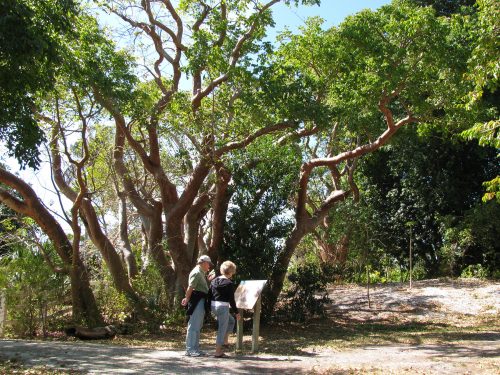Ethnobotany is the scientific study of the interaction between living people, plants, and culture, focusing on how plants are used, managed, and perceived. Components include food, medicine, shelter, fishing, hunting, textiles, clothing, religion, mythology, and magic.

This and future articles will introduce you to the historical importance that the native Florida plants growing on the Pineland site held for past people. Plants create their own chemical components that can be nutritious, poisonous, hallucinogenic, or therapeutic, and humans have been accumulating knowledge of plants and their uses for thousands of years.
The gumbo-limbo (Bursera simaruba) is a large semi-tropical tree with coppery red, shaggy bark that peels off in paper-thin strips. In South Florida it has been called the “tourist tree” because, like the sunburned visitor, it has red, flaking “skin.” On many Caribbean islands today, the bark is a common topical treatment for sunburn as well as skin sores, measles, insect bites, and rashes. A tincture of the bark also functions as an antidote for poisonwood rash, poison ivy, and mango dermatitis. A bark decoction is taken internally for urinary tract infections, colds, flu, sun stroke and fevers. The Calusa may have used the bark in a similar fashion.
Other parts of the tree have also been used. Escalante Fontaneda, who lived among the Calusa, may have meant the gumbo-limbo when he described “el palo para muchas cosas” (a wood for many things). He noted that the sap or resin was used as a medicine, to ward off evil spirits, to safe-guard canoes from wood-boring shipworms, and as glue. Small birds, attracted to the tree for its fruits, were described to have been captured by spreading the tree’s sap on its branches. Small birds landing on the limbs would get stuck, enabling hunters to remove the birds for food or to be sold or bartered. There is also the possibility that gumbo-limbo was used for logs, posts, and pilings in home building. The wood may have been carved into medicinal bowls or other items. It is the primary wood used in carousel horses today.
The Calusa mounds and surrounding areas are filled with this beautiful tree. When you take your next walk on the Calusa Heritage Trail, be sure to note these massive specimens. Although they only a few decades old, they are a wonderful reminder of the many possible ancient roles that the gumbo-limbo played in the lives of the Calusa and their ancestors.
This article was taken from the Friends of the Randell Research Center Newsletter Vol 8, No. 1. March 2009.